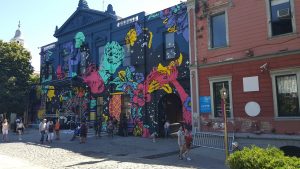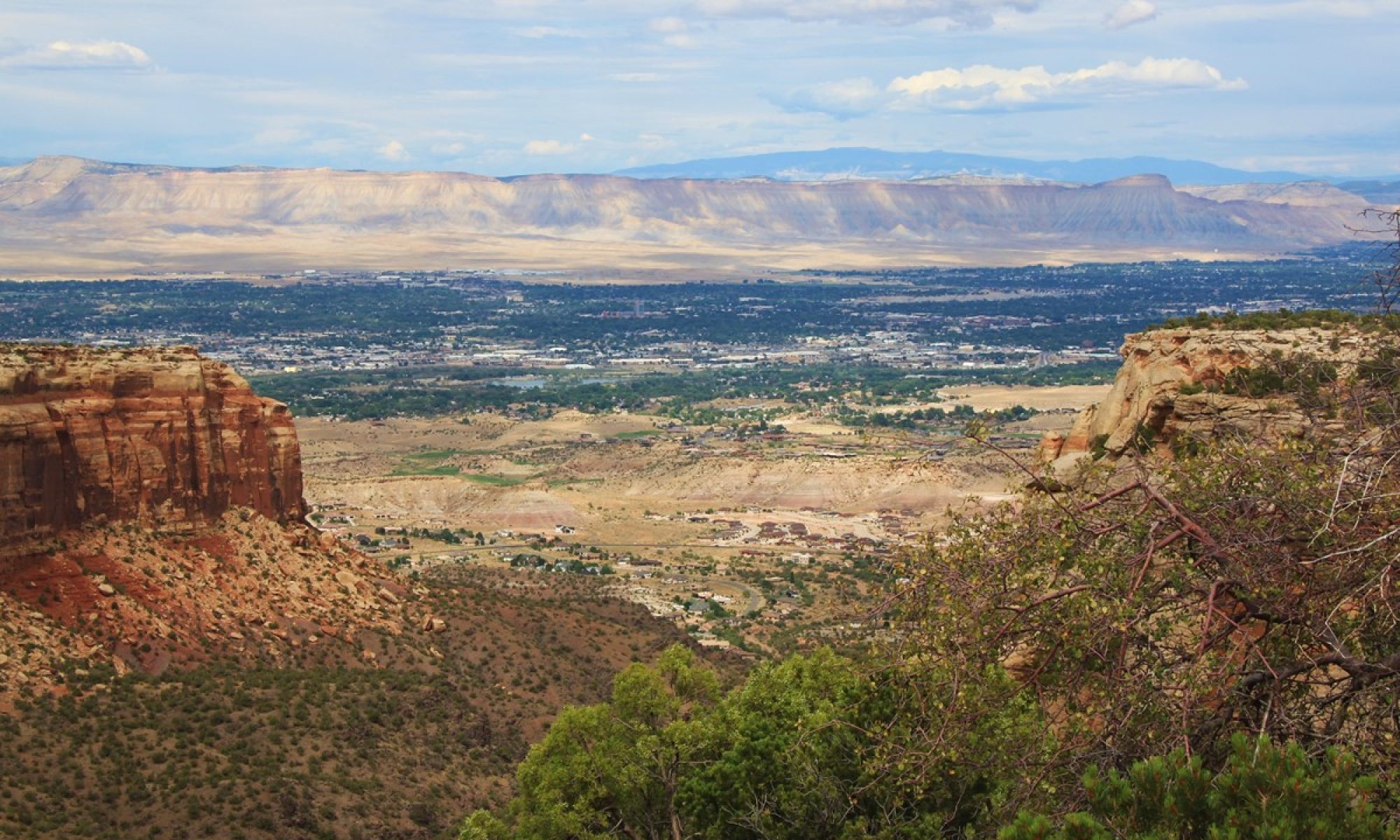For a number of years, we had been looking for a trip to South America that included Easter Island – a location to which we wished to travel and visit. When the opportunity arose, we scheduled this trip beginning on Sunday, January 7th, 2019 and lasting 3 weeks. Our trip would start from Miami, take us to Santiago, Chile and then to Rapa Nui (Easter Island) and back to Santiago. From there, we would fly to Buenos Aires, Argentina and, after a few days, travel to Ushuaia, Argentina where we would board with 150 passengers on the ship, “The Stella Australis”. For five days we would then explore southern Patagonia, Tierra del Fuego and the Chilean Fjords before disembarking in Puenta Arenas, Chile and traveling overland to the Torres del Paine National Park. From here, we would travel to El Calafate, Argentina to explore Los Glaciares National Park and the Perito Moreno Glacier. We would then return to Buenos Aires before returning home through Miami.
Our trip began auspiciously enough as, after we drove 3-hours to Miami International Airport, we boarded our plane to Santiago, Chile, and we immediately met with an engine problem which resulted in an over 2-hour delay forcing us to return to the gate for repairs. Once underway, we flew overnight to Santiago, Chile and were met late Monday morning by our guide, (Mercedes, or “Mechy”) an energetic Argentinean woman with passion, wit and humor. Here we met our fellow 14 travelers for a quick walking tour of the city. Our “local guide”, Felippe, took us on the city’s subway to the city-center, where walked past the many shops of La Moneda to the Presidential Palace (the President no longer lives there). Here we saw the Statue of Salvadore Gossen who is credited with writing the Chilean constitution. However, in 1973 the country’s “leftist” government experienced a coup d’état which included bombing, air force raids and military snipers (likely paid for by the USA’s CIA) downtown on the Palace. With the new Military rule, the USA wielded significant influence for the next 17 years. During this time, Chilean culture went underground, and it wasn’t until 17 years later that democracy finally ruled, and the underground cultures could emerge. Today, car, houses, phones and all the trappings of a socially upward mobile society, paid for with credit, is the norm. Many Chileans aspire for a life imitating what they see in American movies, but with a 19% National Sales Tax that is included in everything one buys. 1990 until today has also seen the nationalization of the minerals industry (principally copper mines) and the success and growth of the Chilean Wine Industry.
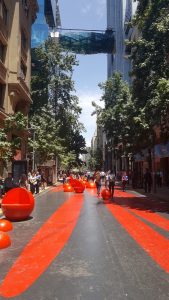
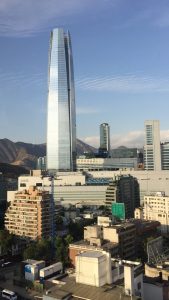
Today, the city’s main square houses a restored and rebuilt Presidential Palace, a Church (The Cathedral of Santiago), other government buildings, and the National Historical Museum. After exploring the history of the square, we rode the subway back to hotel, where we then had a few hours to explore on our own. We checked out the local mall and Starbucks, before settling at a nearby little Italian restaurant, “Don Vito’s”, where we drank “happy hour” Pisco Sours and relaxed in the sunshine. Later that evening, we met the rest of our group and had a short meeting on regarding the next day’s activities, enjoyed a glass of champagne and then walked to Giratorio- a revolving 17th floor restaurant about 10 blocks away – for dinner. Here we drank more Pisco sours and enjoyed a fish dinner with fruit and vegetables and a fruit plate for dessert, all while rotating one revolution per hour to get a complete view of the city.
The next morning, we must say “goodbye” to Santiago, and we travel to the Chilean island of Rapa Nui – Easter Island – to continue our adventure. Five days later we will return briefly to Santiago, but only to make an early morning transfer at the airport and to fly to Buenos Aires, Argentina.
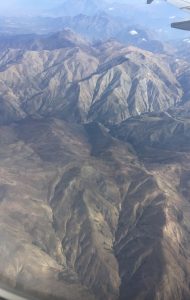
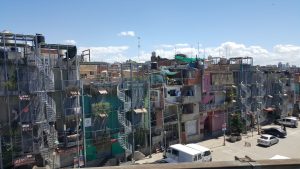
Once in Buenos Aires, we check into the hotel, and then set out to walk to the famous Teatro Colon – the city’s world-class Opera House. The tickets will be for the next day, so we continue our walk to a bookstore that is in an old 1919 theatre that has been beautifully restored. The “Ateneo Grand Splendid” is stunning (and is known as the world’s most beautiful bookstore) that even sells vinyl records. From there we visited a few local shops at the nearby mall (Galerias Pacifico) which has a fresco/mural ceiling painted by 5 renown painters. Then we return to the hotel for a group meeting, (22 of us now) and follow this with an hour’s worth of basic tango lessons.
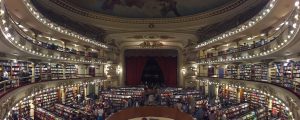
Buenos Aires is a large city whose metropolitan area includes nearly half the population of country! From the hotel, we walked to the old waterfront of the River Plata (the Silver River). The La Plata River forms the border between Argentina and Uruguay, but Uruguay is a small country and has many fewer people in the region. In this area, Puerto Madero, a large canal for ships was dug and was outfitted with cranes and warehouses. The intent was to provide a world-class hub for goods coming from the interior of South America to be able to be quickly transferring on ocean-going ships. However, by the time the port was finished, the size of ocean-going ships exceeded to port’s width and depth, and the port was rebuilt further along the river closer to the ocean. The area was then abandoned and fell into disrepair until the government and private investors recently “gentrified” it by turning the warehouses in restaurants with upstairs’ condos and apartments that now covers a strip of land 2 ½ miles long! The canals are crossed with pedestrian bridges, and historic tall ships and old cranes decorate the wharf. That night we did dinner on our own at one of these waterfront restaurants, “Cabana La Lilas”, where we sat at a waterside table and enjoyed a starter of caprese with eggplant, salmon, cheese bread, gazpacho and prosciutto before tackling a spectacular ribeye steak with baked potato and sautéed mushrooms. All executed with one of the best waiters we’ve ever enjoyed. Truly a meal to remember!
Monday morning, we met with our local guide, Cynthia, and we began a city tour via bus. The first thing our bus must do is cross onto the “9th of July” Avenue, the widest avenue in the world. The 9th of July in 1816 is Argentina’s Independence Day, and the 9th of July Avenue was created by removing an entire city block for several miles! The avenue is 352’ wide and include metro-bus lanes and linear-parks in the middle – it is so wide, that pedestrians need 2-3 traffic-light cycles just to cross all of it. In the middle of the avenue stands a 210’-high obelisk commemorating Argentina’s independence, (the May 25,1810 revolution & the July 9, 1816 signing of their independence), that is surprisingly reminiscent of the Washington Monument. At the one end of the avenue stands a large building with a massive lighted profile of Eva Peron, (Evita), holding a microphone and addressing the people, on it. Even today, she remains as controversial a person as she was in life, and Argentineans are still polarized about her. The Colon Theater backs onto the avenue, since it was built in 1908 before the avenue was created. It fronts onto LaValle Square where there are a series of massively large trees, flowers, (the Ciblo is the National Flower), and various art displays and monuments. It is considered one of the three best Opera houses in the world, and even today, no electronic microphones or amplification is needed or used in its presentations.
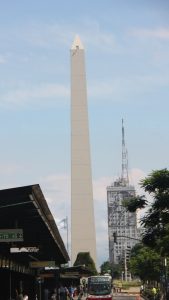
We then head to Mayo Square – the seat of the Executive Offices of the Government. When Buenos Aires was founded in 1580, this square was beside the River Plata, and the city grew south from there. Today, the square is faced by the famous Presidential Palace – the “pink” Palace! It was originally a “fort” that was pink because of it being “painted” with sand, clay and bull’s blood. This was one type of “paint” that would hold-up in the area’s high humidity. Ever since, the tradition of it remaining pink has endured. Also facing the square is the Cathedral (the home-church of the current Pope – Pope Francis), the Cabildo and a bank. The Cabildo served as the residences of important people born in Argentina during colonial times. In those times, a Spanish Colony needed four things to be recognized by Spain: 1) a Town Square, 2) a Fort, 3) a Church, 4) a Cabildo. The Presidential Palace today is only where the President of Argentina works, as he lives in the suburbs of town, and helicopter’s in to work. The Cabildo has been converted to a Museum and the bank sits on the site of what used to be the town’s original cemetery. One of the balconies of the Palace is where Evita famously spoke to the people of Argentina, and it was also the actual site where Madonna famously portrayed her and sang “Don’t Cry for Me, Argentina”, although Evita never said those words.
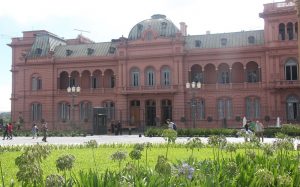
In the 1970’s, after President Peron had died, his Vice-President, Isabel, was overthrown by the military and a dictatorship ruled the country until after the Falkland’s War in 1982. During those year the dictatorship was in power, over 30,000 people went missing in the country, and many are presumed dead or killed by the regime. During those times, it was illegal for people to assemble in groups larger than 2 people, or to stand still in Plaza de Mayo, or to demonstrate. A group of mothers and grandmothers (the “Crying Grandmothers”), wanted to know what happened to their children who had disappeared and began assembling in Plaza de Mayo as individuals who would walk in a circle around the square, wearing white kerchiefs and holding pictures of their missing children. Today, they still assemble every Thursday at 3:30pm to continue the march and the search for the truth. Many of these missing individuals were pregnant women who were killed, and their babies given by the dictatorship to families in Spain as favors. As of today, only 140 of these missing children have been found through DNA testing.

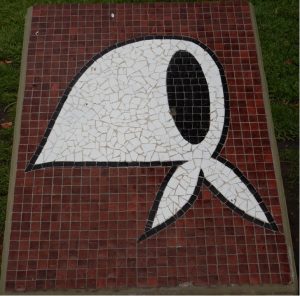
We then went to the London City Coffee House, a favorite haunt of author Arthur Julio Frenencio Cortazar who would write his novels here, to meet and talk with one of these “found children”. Diego was 42 years old, married with two children, living in Miami, but working between Miami and Buenos Aires. His birth mother and father went missing when his mother was 8 months pregnant in 1976, and he was an adopted son of a couple in Spain. His adopted father told him that he was “purchased” in Spain because they desperately wanted a child. After his adopted parents were deceased, Diego went to the “Crying Grandmothers Organization” and was tested and discovered that his 93-year-old grandmother, Delia, was still alive and still looking for him. When he met his Grandmother, she told him how men had come in the middle of the night and took his parents from their home but left his 3-year-old sister asleep on the sofa, whom his grandmother had then raised. Unfortunately, his sister had passed away just the year before and so he could never meet her. His parents were likely beaten and tortured, killed and dumped in the river, like so many others whose unidentified bodies had washed up. His grandmother was one of the original 12 founders of the organization and she had vowed to never give up. Today, he works with his grandmother to help find other missing grandchildren – babies of women taken while pregnant – there are still 370 of them missing! Many believe that the trade in babies was a secondary business of the dictatorship, used to generate income and to trade for favors with high-ranking supporters in Spain and elsewhere in the world. When the dictatorship ended in 1983, the newly elected government put all the dictatorship’s leaders on trial for these crimes, and after a short reprieve, most are still in prison today.
After tea and our conversation with Daniel, we headed down into the Buenos Aires subway which was first line built in 1903 and was one of only 5 in the world at that time. The original subway cars were wooden and were originally built in Belgium in 1903. The subway started with the use of token, which continued until the car were finally replaced in 2013! The new replacement cars are from China and tradition dictated that each train route is color-coded, along with the stations and the trains. This was done to accommodate the large immigrate population in Buenos Aires who could not read. Even today, the subway costs only ~50 cents. Leaving the subway, we reboarded our bus and headed south into La Boca!
Originally, the city of Buenos Aires has grown south towards the mouth of the river, (La Boca means “The Mouth”), which is relatively shallow (<20 ft.), but is up to 150 miles wide. Rumor has it that it was named “River Plata” (Silver River) to lure the many treasure seekers to the area, and the area grew modestly in the 1600’s and 1700’s. However, when the great Yellow Fever plague of 1871 hit the city, all the affluent people moved north, and the Boca area was reclaimed by immigrant Italians, Polish, Spanish, etc. The old houses we repaired with old tin and scraps from the port and ships and painted in whatever leftover paint could be gotten at the docks. What resulted was a colorful melting pot of culture, art and music which gave birth to the Tango. Carlos Cabelle is the most famous of the Tango singers and is said to come from this area. This area is the home of La Boca Football Team (founder 1905) and their blue and yellow colors dominate the landscape. However, these were not always their colors, and history relates that they played a rival club for the rights to Argentinean colors – blue & white, with the loser having to take the colors of the next ship’s flag into port. La Boca lost and the first ship in was a Norwegian freighter. Today, their chief rival is from the northern part of town – River Plata Soccer Club whose colors are red and white. We visit the La Boca neighborhood, (La Caminita), only in the day, as recommended, and work our way through the tango dancers, artists, musicians, souvenir shops and restaurants. From here, we head back to the hotel passing a campus of the University of Buenos Aires. In Argentina, graduation from a public University requires hard work and good study habits, and the University of Buenos Aires is widely regarded as the best. It currently has ~350,000 students spread across all age groups and many campuses. It is here that we see players on horseback practicing an unusual national sport , Pato, played with a ball covered in handles which is thrown from player to player while riding.
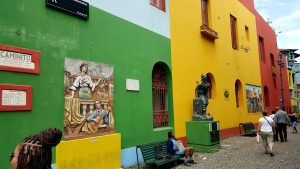
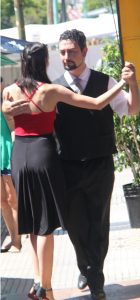
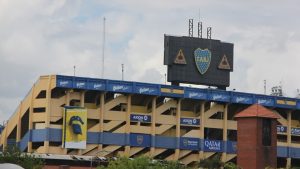
Once democracy was re-established in Argentina in 1983, the country began a cycle of turbulent political and financial crises, which some people finding their savings devalued to half overnight. In fact, during this time, Argentina once had 5 different presidents during a single week. Currently, Argentina is suffering another financial problem with rampant inflation eroding the buying power of its citizens and the country falling deeper into debt. The average income for an Argentinean worker today is only ~$600 USD per month, and the minimum wage is set at ~$250 USD per month.
Upon returning to the hotel, we left for a walk back to the Teatro Colon – the Opera House – for our previously purchased tour. The Teatro Colon was built in 1908, with the best acoustic design possible, and with newly available electricity for lights. It was fully cleaned & restored in 2006-2010. Today, everything in the Opera House is still original, including the different marble foyers and stairways, the art and the French gallery furniture. Busts of musicians look down from above the hallways and one enters the ~3000 person, (400 standing), theater. There is a full orchestra pit with a huge stage – the theater is 20 meters high with 9 decks and 3 underground floors. Even today, no amplification or microphones are needed for the performances on stage because the acoustics are so good.
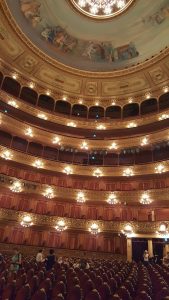
After our tour, we returned to the hotel to get ready for dinner hosted by a local couple for 5 of us. Monica and Roberto are a retired couple living a short 10 minutes away by bus. Their flat is located up 6 floors via elevator and is a roomy 3-bedroom condominium (with a balcony) which they purchased in 1995, and where they raised their 5 children for at least a few years. Roberto was a foreign diplomat (economics) in Germany 3 times and in Brazil. Today, their 5 children are located in California (2), Germany (2) and Brazil. We talked about economics, politics, retirements and the “younger generation”, (of course)! For dinner, we had wine, a posada casserole, (a common dish in Argentina), and a beautiful salad of greens, nuts & fruit with a home-made dressing. For dessert we had a flan with cheese, quince and honey, before saying our “good-byes” and ending our wonderful evening.
The next morning, we left for an early domestic flight to Ushuaia, the southern-most town in the world! On the way to the airport, our driver played us Madonna’s “Don’t Cry for Me, Argentina”, but we would soon return. After our adventures in Terra del Fuego and Torres del Paine, we would fly back to Buenos Aires from El Calafate, Argentina to extend our adventures in this city.
Upon our return on Friday, January 25th, we check back into our same hotel and have a little time to do some final shopping at nearby “Galleria Pacifico” a huge 4-level shopping mall immaculately decorated inside, and housing spectacular ceiling murals. In is located on our hotel’s street and adjacent to the popular pedestrian-only street – Florida Street – a 12-block-long hub of commercial activity and shopping. That night, we meet for our Farewell Dinner, held back at the old Puerto Madero waterfront at a restaurant called “Estilo Campo”, located just down the street from the restaurant we ate at the last time we were here.. Dinner is ribeye Argentinean steak with 2 different sauces, following a “warm-up” with beef empanadas, salad and fries, and followed by wine, ice cream and coffee.
The next morning, we go in search of coffee at one of the many Starbucks in town, only to discover that they are closed until 9:00am in this part of the world. After settling for hotel coffee, we meet our local guide, Cynthia, again, to continue our exploration of the city. Our first stop is slightly north of our hotel in an area called “The Recolleta”. This was a high-class, more expensive part of the city that was built during the “high times” after World War I when Buenos Aires was known as the “Paris of the Americas”. It includes a mix of French, Italian and Spanish architecture, and centered around a Religious Monastery & Nunnery and their Catholic Cemetery originally founded on the outskirts of town in 1732. The Recolleta Cemetery eventually became a “showplace in death” where wealthy people build more and more extravagant mausoleums. Eventually, many of Argentina’s most famous people were buried here, where the space is now all accounted for, and one can only purchase an existing mausoleum. Originally, purchase prices were in the $300-600 USD range, but these have now escalated to ~$60,000 USD, (~$3000+ per sq. meter). Purchase comes with rules and with a ~$3500 USD charge for maintenance per year. Many of the Family Mausoleums have 25-45 bodies entombed there. If the maintenance is not paid, the mausoleum will fall into disrepair, but cannot be sold unless the previous owning family specifically agrees. Today, it is 12-15 acres big and is famous for the spectacular mausoleum architecture, elaborate crypts and their decorations. Also, although there is still the occasional burial there, most Argentineans today prefer cremation.
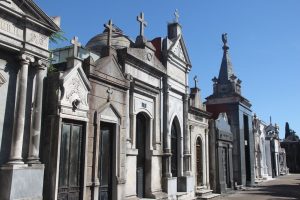
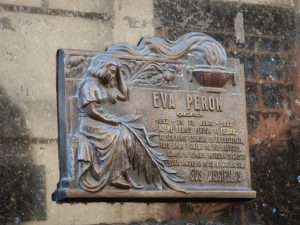
Eva Peron is buried here in her family tomb, along with her sisters, brother and relatives. Eva was born Eva Duarte and was one of 5 children. Her father died when she was only 7, and her mother opened a little hotel and worked hard to support her family. At 17, Eva wanted to be actress, and for the next nearly-10 years found occasional work as a cover. In those days, she was considered very beautiful and she began to take on a role as a radio personality. She met Juan Peron at a festival after his first wife had died of ovarian cancer. They lived together for some time, and then got married. When her husband was elected President of the country’s new Socialist Government in 1946, she took an active role as first lady opening foundations and donating monies and goods to the working-class people in her country, and around the world. She supported building schools and the Peron Government helped redistribute wealth from the Upper-Classes to the Lower-Classes. However, she died soon after of cervical cancer, but not before giving her famous speeches to the people from the Pink Palace balcony. She was only 33 years old! Her body was embalmed and her funeral lasted 44 days, (the country ran out of flowers), and she was displayed in a crystal casket so her people could see her. However, her casket and body soon disappeared and was “lost” for 18 years. Eventually, her body was returned to Argentina, kept at Juan and Isabel’s home for quite some time, until she was finally entombed in the family crypt. Juan Peron’s policies did not sit well with many powerful people in the country and around the world, and his Government was deposed by a violent coup in 1955 and Peron fled the country. In 1973, when the country was ready to have democratic elections again, Juan Peron returned with his 3rd wife, and was elected a second time, with his wife as his Vice-President. However, he died soon after in 1974 and his wife, Isabel, assumed the presidency supporting a more fascist group. This led to more social unrest and a military coup in 1976 which crippled the country economically, removed most social and political freedoms, and gave rise to a very dark period in Argentina’s history until after the Falkland’s was in 1982. When democracy returned in 1983, Argentina took 20 years and seven presidents to did themselves out of economic ruin and social instability. The 1980’s and 1990’s were filled with corruption, protests and economic problems. In 2001, the Government devalued their peso currency by 40% overnight! However, all that changed in 2002 when President Kirchner, a Peronist, stabilized the country’s economy, (voting in presidential elections is mandatory in Argentina). In 2007 he forfeited his presidency to his wife, Cristina, who suffered a 129-day strike by farmers and agricultural unions in 2008, but increasingly grew support for herself, especially after the death of her husband in 2010. Today, Argentina struggles with inflation, (50% in 2018), but maintains a positive outlook and is welcoming a growing Tourist Industry, (second-largest part of the economy).
Leaving Recolleta Cemetery, we head back towards town center along Avenue del Libertador and Avenue Alvear, the avenue of the wealthy during the 1920’s, (from 1880-1930, Argentina was the 8th largest economy in the world). Many homes here are huge and built with imported European materials and with European architects. However, the stock market crash of 1929 wiped out many of the wealthy citizens holdings, and the following depression forced the sale of most of these mansions – in many cases to foreign governments. Today, they serve as the Embassies of many foreign countries having been maintained and restored, and in wonderful, near-original condition.
Next, we went to the area of town referred to as “Little Palermo” – an historic neighborhood with large gardens, a planetarium, Japanese gardens, rose gardens, a jogging track, a large fitness club and the beautiful Palermo racetrack and restaurant. Buenos Aires is a city whose center is home to 3-million people and consists of 48 distinct neighborhoods covering 80 square-miles. The Buenos Aires area covers over 2000 square-miles, consists politically of 15 districts with a total of 9-million people.
Next, we head ~20-miles to the far-north of the city to the area of El Tigre – a deltaic area on the river made up of thousands of islands and historically the location of weekend and summer camps and houses for people of the city to escape to. The area is named for the jaguars that used to roam the area and encompasses 3 provinces and an area as large as The Netherlands. Today, it is a mixture of camps and gated-communities and the country’s capital for rowing and kayaking. Here we take a Tigre Delta boat ride for an hour around a number of islands, (the water is only ~12-feet deep), drinking coffee and eating aljafors (2 soft biscuits with cream in the middle). After the boat tour and a quick lunch, we head back to the hotel to collect our belongings and head to the airport to take our flight home.
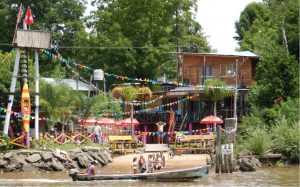
It is now Wednesday February 6 and we are returning to Buenos Aires after only ~2-weeks to begin our trip to Antarctica. We arrive in Buenos Aires on a domestic flight from the Argentinean side of Iguazu Falls, and take a bus from the airport to our hotel, The Emperador, located in the Recolletta area of the city. After checking in we decided to explore a few of the nearby parks which we had seen from the bus on our earlier visit here. We walked to Parc de la Flor to see an Architectural wonder, the Floralis Generica, a giant stainless-steel flower blossom that blooms every morning. It is a work from an Argentinian architect Eduardo Catalano that opened in 2002. At 23-meters high and 18 tons weight it was the first sculpture of movement in the country. It is a complex and precise high technology system that makes the petals (~3500 kg each) open with the first sunlight until its shape is complete, and then close again at sunset daily.
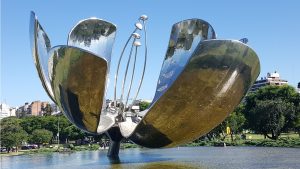
We then had a welcome dinner at the hotel to meet our group that would travel to Antarctica with us. There are 10 of us plus our guide. Marco. Marco is from Chile and has been a guide for 25+ years and has been doing tours to Antarctica for 11 years, although this will be only his second time to the South Georgian Islands. In our travel-group, there are 2 couples from Florida, and one couple each from Illinois, California, and Pennsylvania, and all appear to be very seasoned travelers.
On Thursday morning, after breakfast, we met our local city guide, Eileen, for her unique version of our city tour. She is from Northern Patagonia. We travel south down Avenue Alvear, past the Vatican and Brazilian Embassies to the district of San Telmo where we again visit the Plaza de Mayo and review the early history of the city. From there, it is back to Recolleta Cemetery, and then on to La Boca and their 55,000-seat soccer stadium (The “Candy Box”). (by the way, in order to prevent violence in the stadium, only the home team fans are allowed to attend games in Argentina). After visiting La Caminita again, we travel by bus through the northeast side of Puerto Madero where there are many avenues and parks dedicated to Women and their leaders.
After returning to the hotel, and taking a stroll back to Galleria Pacifico, we were off to Seraphin for lunch, a small local restaurant across from the park in the Recolleta area for pizza and wine – an awesome little local place filled with locals. We then walked back to the Recolleta Art Museum that gets its walls repainted every 2 months with a new mural. We then strolled down Avenue Alvear looking at all the gorgeous mansions that have now been turned into embassies, before making a stop at the Post Office for stamps, on to the grocery for wine, and back to the hotel to pack. The next morning, we fly to Ushuaia to board the M.S. Fram, our Expedition ship to Antarctica.
